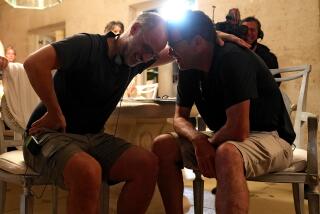Handing the Store to the Kids: Planning Is the Critical Element
- Share via
What kid can resist a circus? The chance to sing “Great Balls of Fire” at an inaugural ball for President Clinton? Or to play deejay at a dance party?
It’s all in a day’s work for the four children of Gail and Bob Levine, musicians and founders of the Beverly Hills-based special events company Bob Gail--The Main Event.
It hasn’t been hard to get their kids, ages 12 to 27, interested in the fast-growing company that has rounded up a circus for the sultan of Brunei’s nieces and nephews, brought rapper LL Cool J and nine other bands to the Super Bowl and performed for the Clintons.
“It’s a natural for kids,” said Bob Levine. “It’s hard to find another job that has all this.”
The built-in fun factor may have helped the company surmount the first obstacle to passing the family business on to a second generation: getting the kids interested. But other steps they’ve taken, including making the business a largely positive part of family life, not pressuring the kids to join the company and giving them meaningful work when they were ready, have helped move the firm through the early stages of succession.
It’s a critical issue for family businesses. Although nine out of 10 family firms believe their business will be controlled by the same family in five years, the statistics show that in the long run, fewer than one-third will pass into the hands of the second generation.
Families tend to shy away from the difficult issues involved in a successful succession--fairness, power, money, to name a few--until it’s too late.
“When you take the family and literally interweave it with a business, it creates issues that are very unique,” said Pat Frishkoff, director of the Austin Family Business Program at Oregon State University.
While there are many legal and tax issues to consider when it comes to succession, she said, “quite frankly, the most difficult are relationship communication kinds of issues. Those are the hardest issues for them to grapple with. Not because they don’t care, but they don’t know how and they care so terribly much.”
The ultimate cost to those who fail can be the family itself.
The Levine children are still in the early stages of succession and the parents, who are in their 40s, are still firmly in control of the company, which has grown rapidly in recent years to $5 million in sales and 45 employees.
“If you are having fun and making money, you are about halfway home” to a successful succession, said professor Craig E. Aronoff, director of the Family Enterprise Center at Kennesaw State University outside Atlanta. But even under those circumstances, he said, family business owners need to “think long term and build to last.”
The Levine family, for example, has successfully entered the first three stages of what Aronoff calls the “seven stages of successor development.” Those stages, which he said last from childhood until the age of about 35, cover the potential successor’s initial exposure to the business.
The youngest two, Scott, 18, and Allyson, 12, are in the first stage, in which important attitudes toward work, the family and the family business are formed. Like their older brothers once were, Scott and Allyson are involved in the business without heavy responsibilities: Allyson playing a Christmas angel at company parties, for example. Scott deejaying at bar mitzvah bashes.
Eric, 27, a computer whiz, got his start playing video games on the business computers and boosting their performance when he was in high school.
As a child, Brian, 24, said he began to catch the family business fever by watching his father on the telephone with clients.
“He literally grew up watching Bob. Even as a little kid he wanted to get on the phone and sell,” said Gail, who moved from New York to Los Angeles in the late ‘70s with her family, $1,500 and the musical instruments they used in their work as bandleaders.
As many family business experts recommend, the Levine kids spent summer vacations and, for the oldest, college years, doing light duty at the company, filing, answering phones and running errands. It gave them a chance to learn the company from the ground up, Gail said.
Nonetheless, Brian and Eric didn’t immediately look upon the family business as their ultimate career goal. But “watching the sheer willpower that made things run” at the company eventually hooked him, Brian says. After graduating from UCLA, the brothers now work the “insane hours” their folks always have.
Eric and Brian are in the second and third stages of Aronoff’s successor development scenario: entry (age 20-30), where the second generation joins the business and begins training, and business development (age 25-35), where the would-be successors acquire the business skills and experience they need.
Both young men have been given “real” jobs.
Brian bounced around a bit until his dad suggested sales, where he has flourished.
“I absolutely went crazy over it. I just loved it. It satisfied something huge,” said Brian, who single-handedly booked and coordinated shows for the 10 bands the company sent to the Super Bowl Village set up for the bowl sponsors. Eric has taken over the company’s computer operations, writing software, building hardware and networking the office with the Culver City warehouse and its mini-village of prop makers, floral designers and technicians for a state-of-the-art video facility. “I really enjoy what I do,” said Eric, who was up till 6 a.m. on a recent night, getting the bugs out of his purchase order software.
That’s a sign that the parents have successfully integrated their oldest sons into the business, said Aronoff. Too many family businesses create nonessential jobs for family members just out of college, frustrating the jobholder as well as fellow employees.
Perhaps the hardest work lies ahead when the Levines begin to navigate the final steps of succession. When the second generation enters its 30s, it’s time for the family to address leadership development, to eventually choose a leader or set up a shared-power arrangement and to begin handing over real authority and responsibility to the kids. The second generation will eventually face the final stage: planning for the next round of succession.
To get to that point, a family business needs a shared vision that goes beyond the bottom line, Aronoff said.
“You really have to be a good communicator,” Gail Levine said. “Above all that, you have to love each other and know that you’re doing something for the common good.”
(BEGIN TEXT OF INFOBOX / INFOGRAPHIC)
Seven Stages of Successor Development
1. Attitude preparation: (Childhood through age 25.) Potential successors develop key attitudes toward the family business and prepare through education and outside work experience.
2. Entry: (Age 20 to 30.) Join the business, receive training and orientation.
3. Business development: (Age 25 to 35.) Acquire needed business skills and experience.
4. Leadership development: (Age 30 to 40.) Work on leadership skills and experience.
5. Selection: Leader is chosen from among multiple candidates or a shared leadership arrangement is worked out.
6. Transition: Greater authority and responsibility are granted.
7. The next round: (Age 45 and up.) Time to plan for the next round of succession.
Source: “Another Kind of Hero: Preparing Successors for Leadership,” by Craig E. Aronoff and John L. Ward
More to Read
Inside the business of entertainment
The Wide Shot brings you news, analysis and insights on everything from streaming wars to production — and what it all means for the future.
You may occasionally receive promotional content from the Los Angeles Times.










